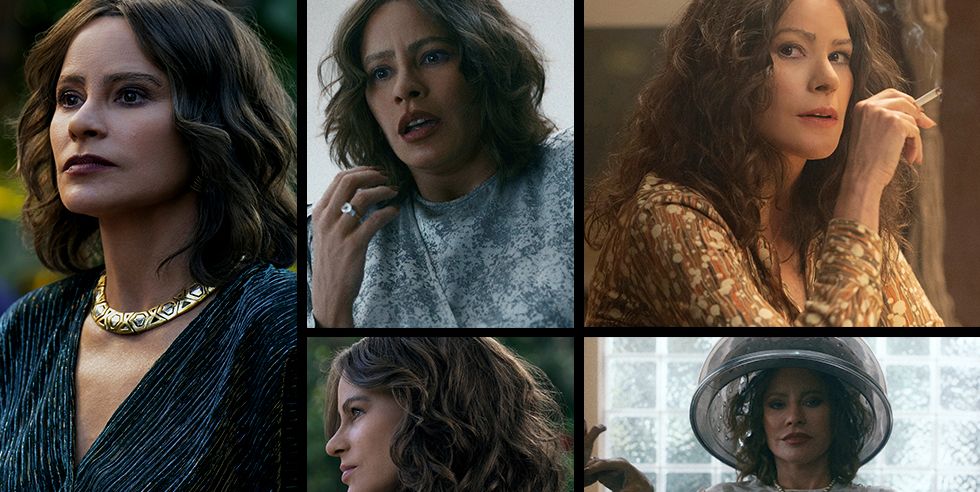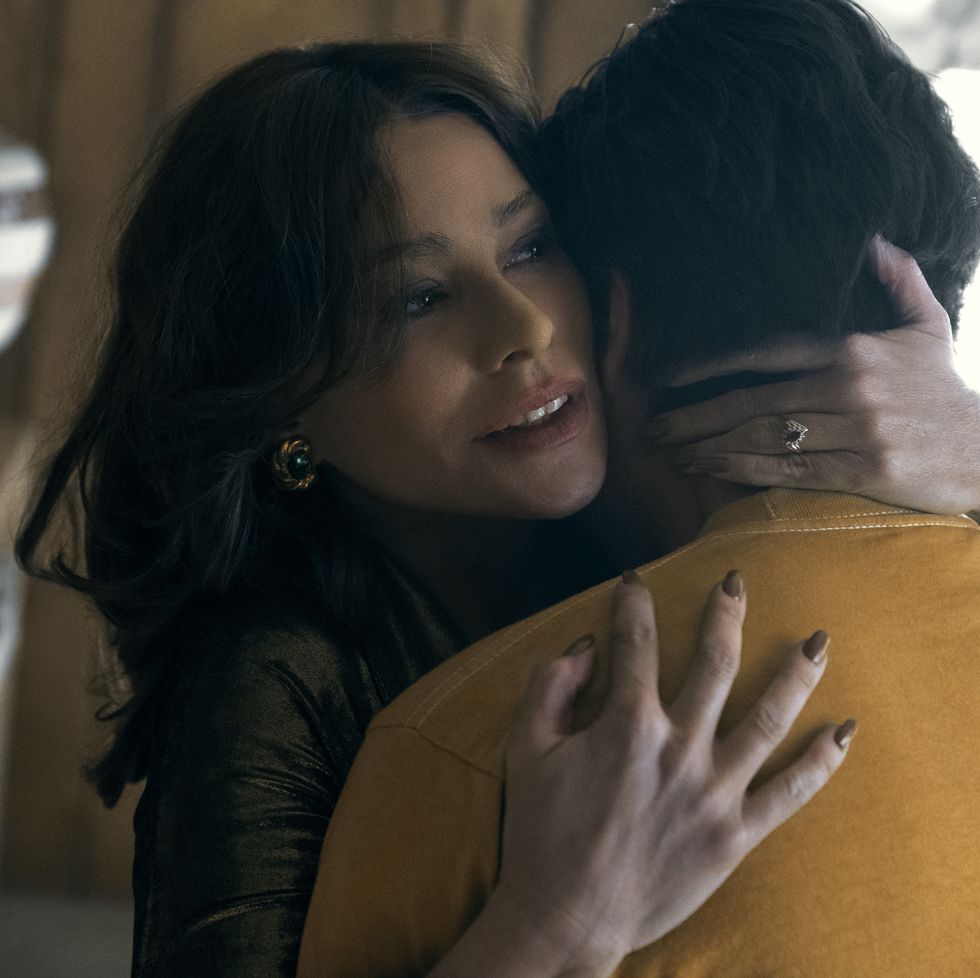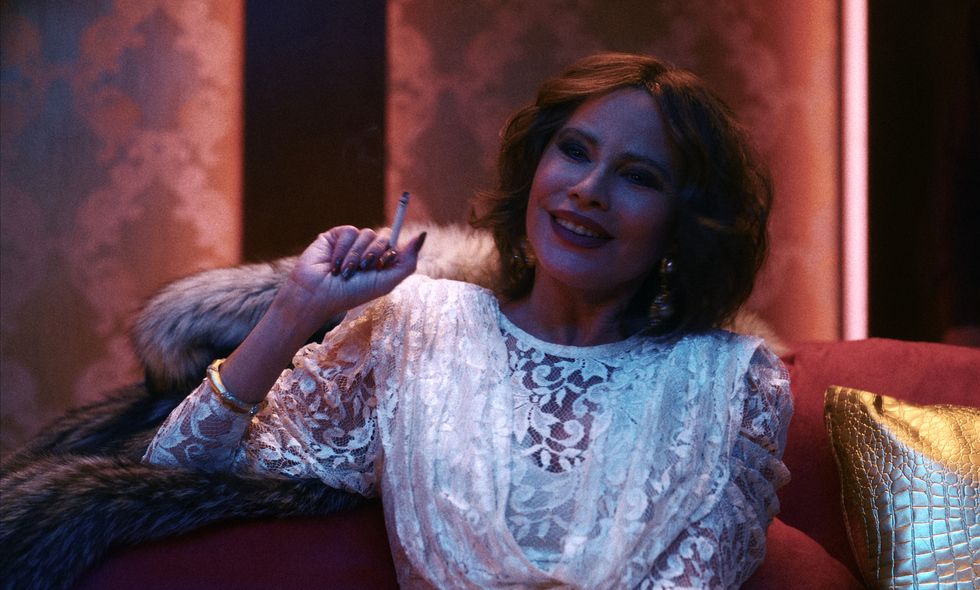From the looks of her wardrobe, it would be easy to mistake Griselda Blanco (Sofía Vergara) for a mob wife, but she, in fact, is the one running a powerful drug empire and earning the nickname “the Godmother.” Griselda’s quest to infiltrate the illicit business boys club is far from easy, and the Netflix limited series from co-creator and showrunner Eric Goldman (Narcos and Narcos: Mexico) depicts this unprecedented rise to infamy. Exclusive parties and nightclubs await, but this world is far from glitz and glam.
Set in the ’70s and ’80s, in the fictionalized drama Griselda, Vergara transforms into the infamous boss who fled Colombia with her three sons before going on to rule Miami in a role that will make you forget all vestiges of Modern Family. After playing one character on a hit sitcom for over a decade, it can be hard to shake this ingrained image, but within the first five minutes of Griselda, all thoughts of Gloria Pritchett have vanished. Costume, hair, and makeup all contribute to how unrecognizable she looks—including a prosthetic nose and fake teeth—and Vergara is earning rave reviews for this breakthrough performance.
“I couldn’t become [Griselda] exactly. But I wanted to disappear. I wanted Gloria Pritchett to disappear,” Vergara told The Los Angeles Times. “That was achievable—I mean, we’ll see. The show hasn’t come out yet, but I think it worked because I didn’t try to become her. I tried to become a woman of that era.” Two-time Emmy Award-winning veteran prosthetics and makeup designer Todd McIntosh worked with this notion in mind. “What we were trying to do was not make her look like Griselda Blanco. We were trying to make her look, not Sofía, and a little bit more plain feature-wise and structure-wise,” McIntosh tells ELLE.com.
Here, McIntosh discusses his last ever job, working with prosthetics, creating Griselda’s beauty look, and the joy of collaborating with Vergara.
The Starting Point
McIntosh has created his fair share of terrifying figures across his 32-year career—including on six seasons of Buffy the Vampire Slayer—but there is a big difference between literal monsters and a human face. “From the beginning, I’ve always said trying to make something look like skin, to make something look real is way more difficult than putting a demon face on and coloring the scales green,” says McIntosh. “We don’t know what demons look like, so whatever you do, we’re going to accept. But we know what a human face looks like—intimately—and it has to be done right to be believable.”
Griselda marks McIntosh’s final project (he retired at the end of the series), but he also didn’t have much prep time as he was hired four days before principal photography started. Stephen Bettles had already designed the prosthetics by then. “They were delivered to me, I put them on, and then created the rest of the makeup,” McIntosh says. Whereas Vergara had been thinking about this series for 15 years, McIntosh had to dive straight in. “I have to say if anyone were a part of this design process and were the apex of it, it would have to be Sofía,” he says. “Every nuance, every inch of the makeup, was passed by her, approved by her, talked out, adjusted. It was a long process, and she was the eye for everything.”
The Eyebrow and Nose Application
McIntosh estimates it took an hour and a half to achieve the initial Griselda Blanco makeup look before hair designer Kelly Kline put on her wig, but “getting into character, certainly [took] three hours.” Instead of sitting in the chair, Vergara would lie down flat. “This was really important for me because gravity was doing things to the makeup if I tried to put it on sitting up. Everything went much better if she was lying down,” he recalls. Griselda’s thinner ’70s eyebrows were the starting point. Vergara was concerned the adhesive would pull out her actual eyebrows, so McIntosh “put protection in her eyebrows and then glued the pieces down” before blending into the skin.
Next up: the nose. “I’d get it in position, and it was a little bit of a jiggle because she had a vision of how it should sit on her face, and we had to reproduce that every day,” McIntosh says. “Once it was glued down. Sofía would sit up and then look at it in the mirror and in her eye, tell me if she liked it or didn’t like it.” McIntosh relishes a collaboration like this with an actor: “They’re invested in what you’re doing. They’re not just laying back and saying, ‘Okay, do whatever you do.’ They’re invested in everything as much as you are, so it was a real treasure to build that kind of cooperative work with her.”
Talking with Fake Teeth
If something wasn’t working, the team would make adjustments, including the upper and lower fake teeth Vergara initially wore. “After a day or so of filming, Sofía found it very difficult to enunciate with both of those,” he says. Working on over 100 episodes of Buffy means McIntosh is well-versed in the various ways teeth can alter your mouth movement: “Even individual fang teeth can change the way you speak, so working with a plate in is something!” So the bottom set was removed, and McIntosh made them match the top by painting Vergara’s real teeth in a “yellowy nicotine tone.” This also reflects how much Griselda smokes throughout the series.
For something like Griselda, subtly in the teeth design is vital. “Initially a couple of the test runs of them were quite crooked. They wanted that something there, and it kept getting pulled back and pulled back till the teeth are not all that out of shape or out of place,” McIntosh describes. “But it was just enough to make that plain look from those beautiful pearly teeth.”
Griselda’s Makeup
While McIntosh was not trying to recreate the real Blanco’s exact look, the aim was to capture her penchant for beautiful clothes and cosmetics through a ’70s aesthetic. One item onscreen Griselda doesn’t tend to change is her burgundy lip color: “I like the idea that a woman in the 1970s might get a lipstick that she likes, and that’s the one she’s going to buy for 10 years. I know tons of women who do that kind of thing.” The teeth plate sticks out a bit, increasing the chances of a cosmetics faux pas that a crime boss (or anyone) wouldn’t want. “There would constantly be lipstick on the plate of teeth; I’d be constantly running in and cleaning that off,” he says.
In earlier episodes, “the makeup changes in its intensity and depth of color only to do with various party sequences.” McIntosh also took cues from costumes designed by Sarah Evelyn and Safowa Bright-Asare in using green and gold eyeshadow. Regardless of the atmosphere or location, McIntosh notes that “underneath everything that is a design is a practicality.” For Griselda’s eyes, he had to consider the plastic film and sealer of the eyebrow blenders that could limit the required alterations. “There’s no real way, once you’ve got an eyeshadow on, to take it off and redo it,” says McIntosh. “I was trying very hard to keep that formula in place as the base, and then we would just shift colors because we were filming many different sequences in different time periods every day—sometimes three or four changes.”
McIntosh revisited some makeup techniques he used in the 1970s, including the triangular eyeshadow shape. To achieve this, they would “put tissue against the corner of her eye and line it up at the end of her eyebrow.” Powder would shift in color when it hit the prosthetic, so McIntosh turned to Temptu, a brand that started as an effects line before going into beauty stores. “Temptu foundations have their little airbrush unit, it’s battery charged, and their makeup comes in these little pods,” says McIntosh. “So I used a nice, warm brown pod Temptu and laid in the triangle shape so that I wasn’t touching the prosthetic because that’s where we started to have issues.”
As the season progresses, Griselda’s appearance reflects the stress of being a drug cartel boss and the perils of trying your own product: “She was getting lots of black around her eyes, and we were sinking underneath her eyes with shadow, making her cheeks a bit more hollow. We did go through a transformation as she was getting paranoid.”
Despite the prosthetics, it’s Vergara who completes the transformation as she embodies this role with each ebb, flow, and challenge thrown Griselda’s way. “I think most of that is her performance. We changed a few things,” says McIntosh. “We adjusted her nose, we changed her eyebrows to look thinner and more 1970s in their shape and arch, and we put 1970s makeup on her, but it still, to me, was Sofía.”

Emma Fraser is a freelance culture writer with a focus on TV, movies, and costume design. You can find her talking about all of these things on Twitter.



